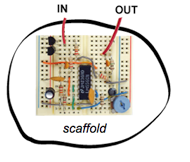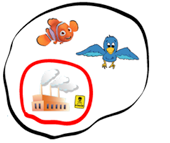UCSF
From 2007.igem.org
(Difference between revisions)
(→Media) |
|||
| (69 intermediate revisions not shown) | |||
| Line 1: | Line 1: | ||
| - | == | + | <div id="mainpage"> |
| + | [[Image:logo6.png]] | ||
| + | </div> | ||
| + | {| cell spacing="1" style="border: 1px solid" | ||
| + | |width="886px" align="center" style="font-size:24px"| | ||
| + | '''Location, Location, Location: <br> Directing Biology through Synthetic Assemblies and Organelles''' | ||
| + | <p style="font-size:10pt">[[UCSF/Main_Introduction|A General Introduction]]</p> | ||
| + | |- | ||
| + | {|style= | ||
| + | |[[Image:UCSFProject1.png|left]] | ||
| + | |<p style="font-size:14pt">Project 1: Protein Scaffolds as a Molecular Breadboard</p> | ||
| + | Using synthetic protein scaffolds to control information flow of a kinase pathway in eukaryotic cells.<br> | ||
| + | [[UCSF/Intro|Read More]] | ||
| + | |- | ||
| + | |[[Image:UCSFProject2.png|left]] | ||
| + | |<p style="font-size:14pt">Project 2: Creating a Synthetic Organelle</p> | ||
| + | Engineering phosphoinositide "barcodes" to create an intracellular membrane-bound chassis for | ||
| - | + | synthetic biology applications in eukaryotic cells. <br> | |
| - | + | [[UCSF/Organelle_Intro|Read More]] | |
| + | |} | ||
| + | {| cell spacing=“1” | ||
| + | |width="333px" bgcolor=#fc6 | | ||
| + | <!-- PEOPLE HEADER --> | ||
| + | <h3><html><img src=http://openwetware.org/images/3/39/Icon_groups.png alt=People> | ||
| + | </html><font color=black>People | ||
| + | <hr/> | ||
| + | <!-- END PEOPLE HEADER --> | ||
| + | ===Students=== | ||
| + | *[[Michael Chen]] (UC Berkeley) | ||
| + | *[[Eric Chou]] (Lincoln High) | ||
| + | *[[Jimmy Huang]] (Lincoln High) | ||
| + | *[[Lauren Jann]] (Lincoln High) | ||
| + | *[[Eric Meltzer]] (Palo Alto High) | ||
| + | *[[Alexander Ng]] (Lincoln High) | ||
| + | *[[Robert Ovadia]] (Lincoln High) | ||
| - | + | ===Instructors=== | |
| - | + | *[[Noah Helman]] | |
| - | + | *[[Andrew Horwitz]] | |
| + | *[[Sergio Peisajovich]] | ||
| + | *[[David Pincus]] | ||
| + | *[[Ryan Ritterson]] | ||
| + | *[[Nili Sommovilla]] | ||
| + | *[[Reid Williams]] | ||
| + | *[[Angela Won]] | ||
| + | ===Faculty Advisors=== | ||
| + | *[http://www.ucsf.edu/limlab/ Wendell Lim] | ||
| + | *[[Hana El-Samad]] | ||
| + | *[http://kortemmelab.ucsf.edu/ Tanja Kortemme] | ||
| + | *[http://www.voigtlab.ucsf.edu/ Chris Voigt] | ||
| - | == | + | ===Planning & Development=== |
| - | [http://openwetware.org/wiki/IGEM:UCSF/2007 | + | |
| + | *[[/Weekly Meetings/]] | ||
| + | *[[/Past Presentations/]] | ||
| + | *[[/Papers of Interest/]] | ||
| + | *[[Logo Galore...]] | ||
| + | |||
| + | ===Media=== | ||
| + | *[http://igem.ucsf.edu UCSF iGEM Homepage] | ||
| + | *[[IGEM:UCSF/2007/Photos | Photos]] | ||
| + | *[[/Videos/]] | ||
| + | *[http://169.230.117.36/today/cache/feature/200708022.html in ucsf news!] | ||
| + | *Who's been checking us out? | ||
| + | <html> <a href="http://www3.clustrmaps.com/counter/maps.php?url=http://openwetware.org/wiki/IGEM:UCSF/2007"><img src="http://www3.clustrmaps.com/stats/maps-no_clusters/openwetware.org-wiki-IGEM-UCSF-2007-thumb.jpg" /> | ||
| + | </a> </html></font> | ||
| + | |||
| + | |||
| + | |width="555px" bgcolor="gainsboro" | | ||
| + | <!-- COMMUNITY HEADER --> | ||
| + | <html><h3> | ||
| + | <img src="http://openwetware.org/images/b/b9/Icon_board.png" alt=Resources> | ||
| + | </html>The Project</h3> | ||
| + | <hr/> | ||
| + | <!-- END NEWS HEADER --> | ||
| + | |||
| + | ===About Us=== | ||
| + | *[[/Our Story/]] | ||
| + | *[http://igem.ucsf.edu Our official website] | ||
| + | |||
| + | ===A Guided Tour through the Project=== | ||
| + | *[[/Project Description/]] | ||
| + | *[[/Main Introduction/]] | ||
| + | *'''Project One: Engineering Protein Complexes''' | ||
| + | **[[/Intro/]] | ||
| + | **[[/Results/]] | ||
| + | **[[/Conclusions/]] | ||
| + | *'''Project Two: The Synthetic Organelle''' | ||
| + | **[[/Organelle Intro/| Intro]] | ||
| + | **[[/Results_P2/| Results]] | ||
| + | **[[/Conclusions_P2/| Status]] | ||
| + | *[[/Overall Conclusions/| Overall Conclusions]] | ||
| + | |||
| + | ===Behind the Scenes=== | ||
| + | *'''Methods and Materials''' | ||
| + | **'''Project One''' | ||
| + | ***[[/Cloning Strategy1/| Cloning Strategy]] | ||
| + | ***[[/YeastStrains1/| Yeast Strains]] | ||
| + | ***[[/Flow Cytometry1/| Flow Cytometry]] | ||
| + | **'''Project Two''' | ||
| + | ***[[/Cloning Strategy2/| Cloning Strategy]] | ||
| + | ***[[/YeastStrains2/|Yeast Strains]] | ||
| + | ***[[/Flow Cytometry2/|Flow Cytometry]] | ||
| + | ***[[/Microscopy/|Microscopy]] | ||
| + | *[[IGEM:UCSF/2007/Plasmids | Plasmids & Sequences]] | ||
| + | <br><br><br><br><br><br><br><br><br><br><br><br><br><br> | ||
| + | __NOTOC__ | ||
Latest revision as of 17:30, 18 April 2008
|
Location, Location, Location: |
Project 1: Protein Scaffolds as a Molecular Breadboard Using synthetic protein scaffolds to control information flow of a kinase pathway in eukaryotic cells. | |
Project 2: Creating a Synthetic Organelle Engineering phosphoinositide "barcodes" to create an intracellular membrane-bound chassis for synthetic biology applications in eukaryotic cells. |
|
|



